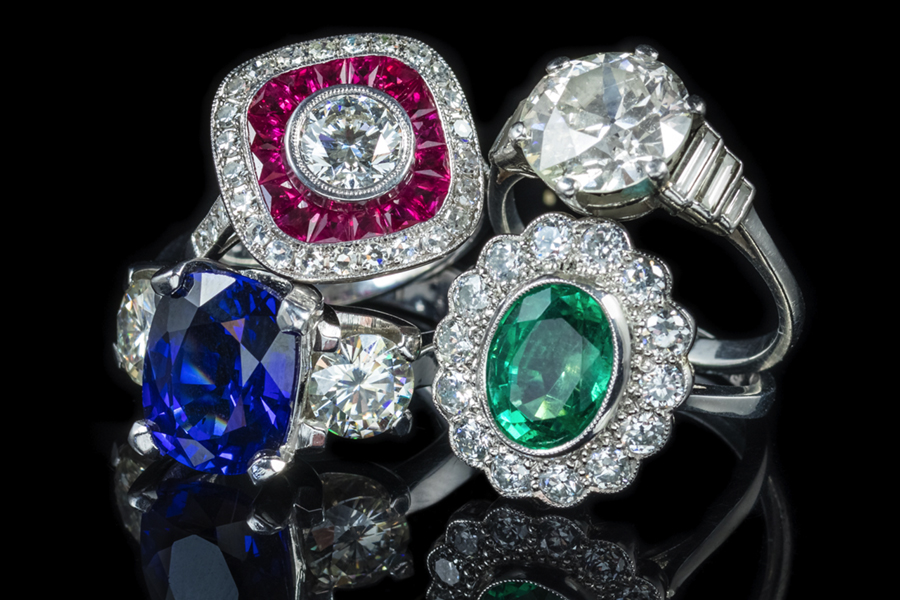A Buyers Guide to Antique Jewellery
Antique jewellery offers you the opportunity to make an investment in a piece of art that has been enjoyed for hundreds of years. Acquiring a true historic piece can be a tremendously rewarding experience, but what should you look out for when making this kind of purchase?
At Laurelle Antique Jewellery we have been working with antique jewellery for over forty years, and we appreciate how daunting it can be when you are just getting started. There are a bewildering array of antique pieces on offer, and it is easy to be overwhelmed by the sheer choice available.
It’s worth considering the condition of the piece first. Most antiques will have some wear and tear, but any reputable seller will be open and honest when disclosing any marks or imperfections which the piece has acquired over the years.
Some issues, such as loose stones, can be easily corrected by a jeweller, and many dealers will offer to take on these repairs as a condition of the sale. Repair work on gemstones can be more complex. Whilst many precious stones can be improved with modern techniques it is worth consulting with an expert, as the piece may be more valuable if left in its original condition. Some gemstones, such as emeralds, naturally contain inclusions and internal flaws, so the presence of these marks identifies them as separate from flawless, synthetic emeralds.
 Although it is important to make sure that the piece you are looking at is in good condition it’s equally important to know when it was made. To help you get started we’ve outlined a few of the key points to be on the lookout for in the four eras that we specialise in:
Although it is important to make sure that the piece you are looking at is in good condition it’s equally important to know when it was made. To help you get started we’ve outlined a few of the key points to be on the lookout for in the four eras that we specialise in:
The Georgian Period (1714 – 1830)
Georgian jewellery predates some of the innovations in gold alloys which occurred in the later Victorian period. This means that every piece of gold jewellery from the period is made from 18ct gold or higher. Higher gold content means that the metal is more valuable, but also relatively soft and easily damaged. This accounts for the fact that there are fewer pieces from this period which have survived into the modern day.
Softer gold meant that jewellers avoided thin filaments in their decorative metalwork. It also meant that they often enclosed their gemstones in more robust galleries, which were often foil-backed to reflect light back at the observer and show the stones quality to a greater degree.
You can read more about buying Georgian jewellery here.
The Victorian Period (1839 -1901)
The Victorian period saw the introduction of lower carat weight gold, which was stronger than that used in earlier periods. This increased strength allowed jewellers to develop open galleries which permitted a much greater amount of light to flow through gemstones, as well as much more intricate gold wire-work.
Victorian jewellery was closely linked to the life of Queen Victoria and her love for her Prince Albert. Early Victorian pieces carried romantic motifs such as flowers and hearts as Victoria and Albert’s courtship began, but after Albert’s death the mood of queen and country turned towards more sombre themes. Mourning jewellery, and dark stones such as onyx and jet were prevalent in such pieces.
You can read more about buying Victorian jewellery here.
The Edwardian Period (1901 – 1914)
The Edwardian period was shorter by far than both preceding periods as King Edward’s reign was comparatively brief. Whilst many Edwardian pieces have survived in a much better condition than earlier antiques there were far fewer produced, which has kept their value high.
Edwardian jewellery used the technological innovations perfected during the Victorian era to create intricate, finely crafted pieces which drew inspiration from European styles. Edwardian jewellery was ostentatious, and they were particularly fond of garlands or clusters of precious stones.
You can read more about buying Edwardian jewellery here.
The Art Deco Period (1920 – 1935)
The Art Deco movement was a time of international innovation in the arts. The style, focusing on strong geometric patterns and abstract patterning, influenced everything from architecture to homewares, and the jewellery from this era is both remarkable and distinctive.
The creation of White Gold was perfected in 1920 and heavily employed in the jewellery of the age. Platinum provided a new standard of luxury for those who could afford it, and many pieces contain large gemstones such as aquamarine.
You can read more about buying Art Deco jewellery here.
 Questions and Further Advice
Questions and Further Advice
At Laurelle Antique Jewellery we are always happy to share our knowledge and experience to help you to make the most informed decisions when purchasing a piece of antique jewellery. We offer flexible interest free finance payment options, free ring sizing and repairs on all pieces, as well as a generous returns policy to make sure you are happy with your purchase.
You can speak to a member of our expert team by calling England: 0333 700 4500 or via email at [email protected].
Looking for more information on Antique Jewellery? Why not take a look at our collection of helpful articles here.
ADVERTORIAL






















